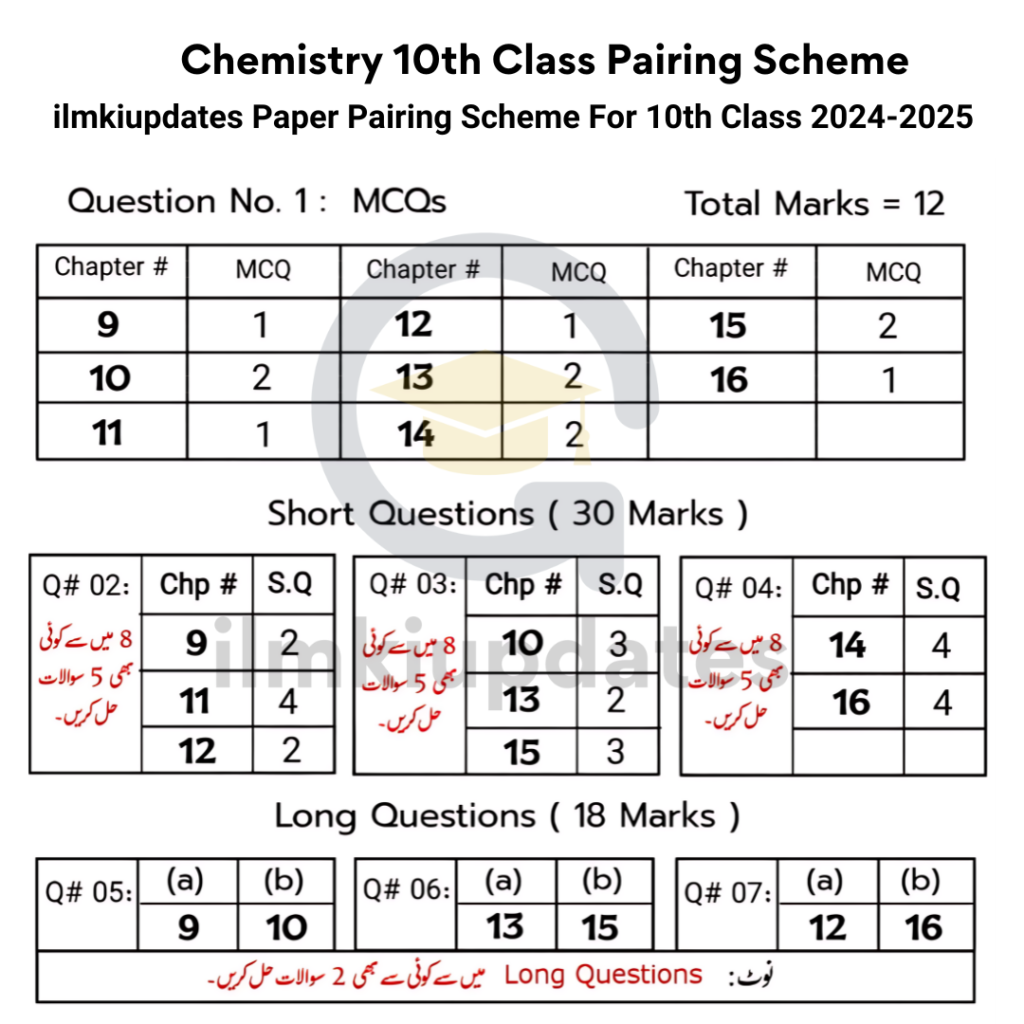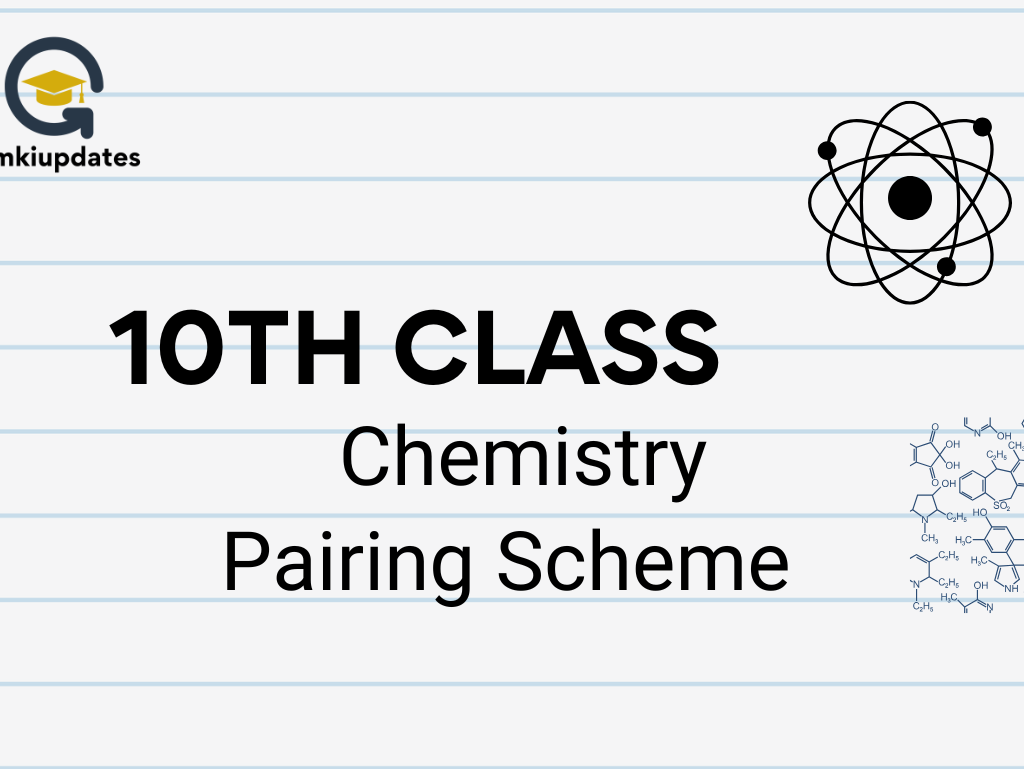Negating the Common Belief: It’s Just Another Study Guide
There’s a common myth that the 10th class chemistry pairing scheme is just another boring, complicated document that doesn’t really help. Well, I’m here to tell you that’s not true! If you think of it as just a random list of topics, you’re missing out on the power it holds to shape your exam preparation. The pairing scheme isn’t just a suggestion—it’s a strategic guide to how your board exams will play out. It’s designed to help you focus on what matters, cut down on unnecessary study time, and boost your confidence in tackling your chemistry exam head-on.
What is the 10th Class Chemistry Pairing Scheme?
If you’re wondering, “What exactly is a chemistry pairing scheme?”, you’re not alone! Many students don’t fully understand it, but it’s one of the most useful resources you can have when preparing for your exams.
In simple terms, a pairing scheme is like a roadmap for your chemistry exam. It shows you how the chapters are grouped for short and long questions. This means you’ll know exactly which topics are paired together, making it easier for you to study. By focusing on the right topics, you’re optimizing your time and energy, allowing you to cover more important areas without feeling overwhelmed.
For example, in 2024, the 10th class chemistry pairing scheme could show that topics like chemical bonding and periodic table are frequently paired for long-answer questions, while chemical reactions might be paired with acids and bases for short-answer questions. Knowing this allows you to prepare effectively.
So, why is this pairing scheme so important for 10th grade chemistry students? Well, here’s the thing: without it, you’re essentially going into the exam blind, studying everything equally. With the pairing scheme, however, you have a targeted plan to focus on the high-yield topics and leave out the low-priority ones.
You might be wondering if the scheme is different for different boards. And yes, it is! For example, the Punjab Board chemistry pairing scheme might have some differences from the Federal Board or Sindh Board. But the basic idea remains the same: knowing what’s likely to be on the exam, and how it’s paired together.
How to Use the 10th Class Chemistry Pairing Scheme Effectively
Now that you know what the 10th class chemistry pairing scheme is, it’s time to talk about how you can make it work for you in the best possible way.
Many students get the pairing scheme and think, “Okay, now what?” Well, just getting the scheme isn’t enough. It’s about using it strategically to maximize your exam performance.
Here’s how to get the most out of it:
- Focus on High-Weightage Topics:
Some chapters have a higher weightage in the exam. For example, in many board exams, chemical bonding, periodic table, and organic chemistry often make up a huge portion of your exam marks. If you know these chapters are paired frequently for long questions, it’s smart to spend more time on them.
By understanding the 10th class chemistry paper pattern, you can prioritize these chapters over less important ones. For example, if the scheme shows that acids and bases are only paired for short-answer questions, you might decide to study that one last. - Don’t Over-Complicate Things:
A common mistake many students make is over-studying. You don’t need to memorize everything in the book. The chemistry pairing scheme for 10th class helps you eliminate unnecessary topics, focusing only on the chapters and questions that matter the most. You’ll save time and study smarter, not harder. - Create a Study Schedule:
With your pairing scheme in hand, it’s time to create a study timetable. Break down the chapters and assign them to specific days or weeks. For example, if you’re preparing for your chemistry exam, and you know organic chemistry and chemical bonding are paired frequently, start with those. Then, move on to topics like acids, bases, and salts that have a lesser weightage but are still important. - Don’t Forget Short Questions:
While long questions are important, short questions are just as crucial. These are the quick wins that can boost your marks. The pairing scheme shows which chapters are likely to come as short questions. So, make sure to allocate some time to prepare them too. - Use Past Papers and Guess Papers:
Another way to make the most of the pairing scheme is by practicing past papers and guess papers. These will give you a good idea of how the questions are framed and how the chapters are paired in the actual exam. By solving them, you’ll get a feel for the exam pattern and understand how to manage your time on exam day. - Stay Calm and Confident:
Lastly, it’s essential to stay calm while preparing. The pairing scheme is a tool to help you prepare efficiently, but it’s not the only factor that will determine your success. Stay confident in your studies, and use the scheme to guide your preparation.

Now that you have the 10th class chemistry pairing scheme, it’s time to take action! Knowing which topics are likely to come in the exam is a game-changer. But how do you actually use this information to your advantage? Let’s break it down:
- Prioritize High-Weightage Topics
The pairing scheme clearly shows you which chapters have the highest weightage in the exam. For example, chemical bonding, periodic table, and organic chemistry are often paired together for long-answer questions. These topics usually carry a heavy mark value, so it makes sense to spend more time mastering them. If the scheme shows that acids and bases are less likely to show up in long-answer questions, you can focus on them for short-answer preparation instead.
The key is to prioritize topics that have a higher chance of appearing in the exam. By focusing on high-weightage topics first, you’ll increase your chances of scoring big in the exam. - Avoid Overloading Yourself with Unnecessary Information
It’s easy to fall into the trap of studying every chapter because you think it will improve your chances. However, this is counterproductive. The pairing scheme helps you cut out unnecessary chapters, so you don’t end up wasting time on low-yield topics that aren’t likely to appear in the exam.
For instance, if a topic is listed as “not paired” or only appears as a short question, you don’t need to stress about memorizing every detail. Instead, focus on the essential points and formulas that could be asked in short questions. - Break Down the Scheme into Manageable Chunks
Once you know which chapters to prioritize, it’s time to break them down into smaller, manageable chunks. Here’s a tip: create a weekly study plan based on the pairing scheme. For example:- Week 1: Focus on chemical bonding and periodic table.
- Week 2: Move on to organic chemistry and hydrocarbons.
- Week 3: Review acids, bases, and salts, which are often paired together for short-answer questions.
- The beauty of the pairing scheme is that it allows you to structure your study time more effectively, giving you time to cover the most critical topics while keeping everything organized.
- Practice Past Papers and Guess Papers
Another way to get the most out of the pairing scheme is by practicing with past papers and guess papers. These papers give you a clear idea of how the pairing scheme plays out in real exams. You can see which topics appear regularly and how they are framed in exam questions.
You can also practice with chemistry guess papers for 10th class, which focus on the most probable questions based on the scheme. This will help you be exam-ready and reduce surprises on test day.
6. Don’t Skip Short Questions
Many students think they can ignore short questions because they’re easier. But short questions can make a huge difference to your overall score. By using the pairing scheme for 10th class chemistry, you can figure out which chapters are likely to show up in short-answer questions. Spend time practicing these and focus on key formulas and definitions that frequently appear.
Remember, a solid performance in short questions can give you a boost, especially if you’re running out of time or unsure about the longer answers.




